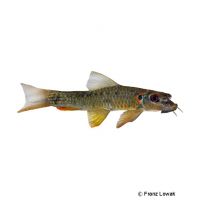Tunga Garra (Garra bicornuta)
| Tunga Garra Garra bicornuta | |
|---|---|
| Name | Tunga Garra |
| Name Lat. | Garra bicornuta |
| Synonym | Rhino Garra |
| Family | Carps |
| Family lat. | Cyprinidae |
| Order | Carps |
| Order lat. | Cypriniformes |
| Origin | India |
| Habitat | Mountain streams |
| Diet | Omnivore |
| pH | 6.0-7.5 |
| Behavior | Peaceful |
| Keeping | Group |
| Care Level | Moderate |
| Reproduction | Egg scatterer |
| Breeding | Difficult |
| Life Span | 2-5 years |
| Protection | No |
| Metric Units | |
| Size | 12-15 cm |
| Temperature | 15-23 °C |
| Hardness | 2-12 °dH |
| Aquarium | 200 l |
| US Units | |
| Size | 4.7"-6.0" |
| Temperature | 60-73 °F |
| Hardness | 36-214 ppm |
| Aquarium | 50 gal |
Distribution and habitat
Horned Sucker Barbs are native to the Tunga River system in the Western Ghats (India). They live in mountain streams with gravelly bottoms and seasonally varying water levels.
Maintenance
The aquarium should be structured with stone structures (caves), boulders and roots as well as free gravel areas and have dense planting in places. A substrate of sand or fine gravel, oxygen-rich water and some current is ideal.
No ammonia, ammonium and nitrite should be detectable, the nitrate value should not exceed 100 mg/l. To ensure the water quality and the oxygen content, a filter adapted to the aquarium size and a heater are required, as well as lighting for the species-appropriate day-night rhythm of the animals.
Diet
They feed mainly on the vegetable cover (growth) of stones, wood, plants, etc. and the microorganisms found in them. For a balanced diet, feed them once a day with a high-quality sinking dry food (granules, tablets) as well as cyclops, daphnia or mosquito larvae (live or frozen). In addition, they need vegetable food, such as crushed peas, scalded spinach, zucchini slices or algae leaves.
Only feed as much as will be eaten within a few minutes. A regular and varied diet promotes health and increases resistance.
Behaviour and compatibility
They are sociable and relatively peaceful fish that should be kept in a group of 3-4. Occasionally they try to suck on larger fish. Socialization with robust barbs or loaches is well possible. 
Basically, only compatible fish species with similar demands on water conditions and water temperature should be socialized.
Sex dimorphism
Adult males are more slender than females and develop distinct tubercles on the head.
Reproduction and breeding
They are free spawners that spawn over gravel bottom. After 36-48 hours the young hatch. Their yolk sac is used up after about 4 days and they swim freely. The larvae do not yet have a sucking mouth. It takes about 2 months for their sucking mouth to form
Fry must be fed several times a day with special rearing food (Artemia nauplii). In community tanks breeding is hardly possible, because the fry are easy prey.
Important
They are good algae eaters. They do not tolerate high temperatures well in the long run.
Strong lighting promotes the growth of algae, which serves as food for them. The aquarium should be well covered, because they like to jump.
The well-being of the fish should be checked regularly. Temperature should be checked daily, pH, hardness and nitrate levels at least every 14 days. Regular partial water changes are recommended, even if the contaminant level has not yet reached the upper limit. Sudden changes in water quality should be avoided. Newly introduced fish must be accustomed slowly to the water in the aquarium
Further literature can be found in your pet store.
References
Text: petdata; Image: Franz Lowak
Source: BMELV (1998): Tierschutzgutachten - Haltung von Zierfischen (Süßwasser); BAENSCH & EVERS (2004): Aquarien Atlas Bd. 6, Mergus Verlag; ENGELMANN (2005): Zootierhaltung - Tiere in menschlicher Obhut: Fische, Verlag Harri Deutsch
- Gemäß § 21 Abs. 5 Tierschutzgesetz idgF
